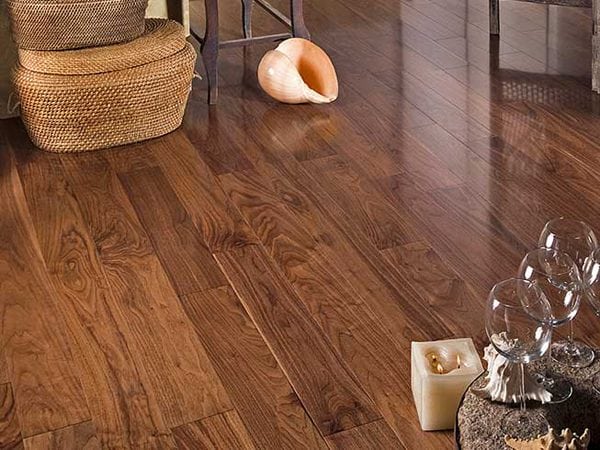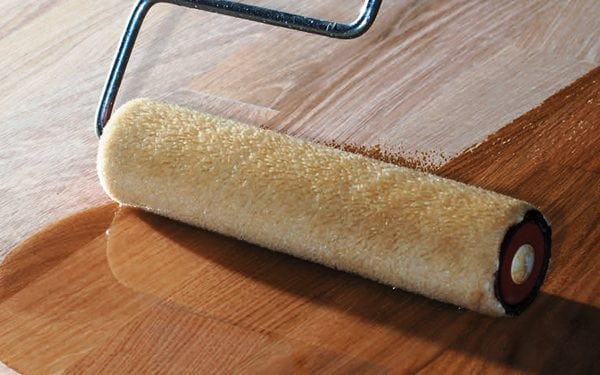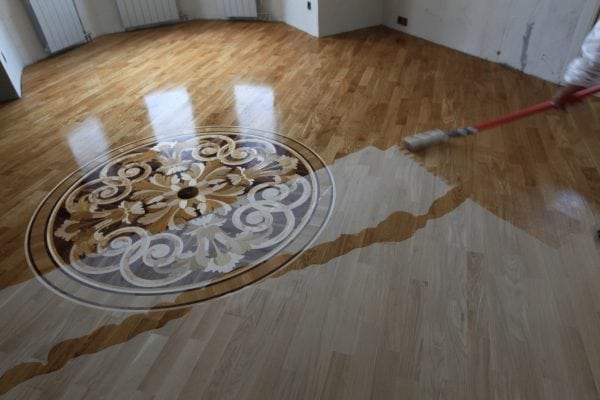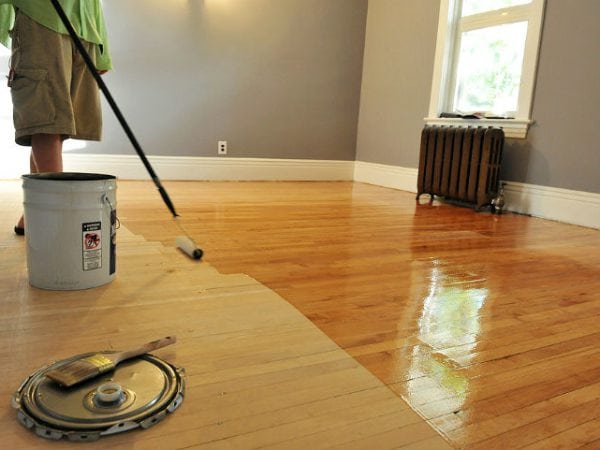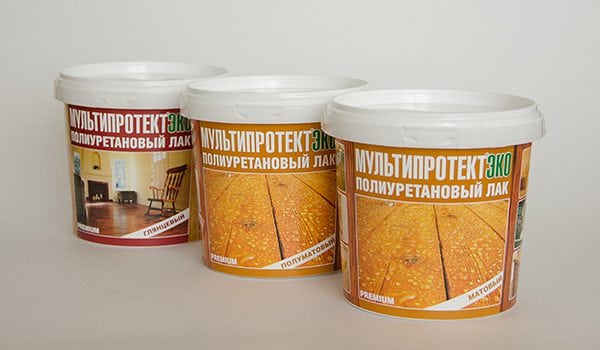The choice of high-quality parquet is the key to only half the success in creating a wear-resistant and aesthetic floor. Otherwise, the parameters of the flooring depend on the correct installation and the correct choice of the varnish composition.
- Production of water-based parquet varnish
- Features of water-soluble paints and varnishes
- Types of water-based paints and varnishes
- Leading manufacturers of water-based varnishes
- Application features
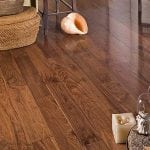
For many years, the parquet floor has been the embodiment of a unique style and luxury. Despite the emergence of a large number of new floor coverings, parquet still remains one of the most popular floors not only for apartments, but also for private houses.
At the present stage, various types of varnish are used to protect the parquet flooring, which prevent the destruction of wood under the influence of chemical and mechanical factors. In addition, the paintwork provides ease of care for the wooden coating.
One of the most common coatings is water-based varnish, designed specifically for parquet. Due to its many positive qualities, this paint material is in a winning position compared to other similar compositions.
to contents ↑The most popular in this case is water-based polyurethane varnish. This quick-drying composition has many advantages, which distinguishes it from other types of paintwork.
Production of water-based parquet varnish
Modern water-soluble varnish is obtained by mixing water with other components of the composition. After that, the resulting mixture was diluted with a small amount of solvent so that its proportion did not exceed 15%. For mixing, special equipment is used that works at high speed.
If you apply a water-based polyurethane varnish on the floor, then water will immediately evaporate from it, then the solvent will begin to evaporate and, at the last stage, the binder components evaporate. As a result, a film is formed that dries quickly enough. At the same time, a certain amount of time must pass for the lacquered surface to become final.
Features of water-soluble paints and varnishes
Wear resistance is an important property that distinguishes precisely polyurethane varnish from other water-based compounds. It is worth noting that the first water-soluble paints and varnishes formed an insufficiently strong film on a wooden surface. Therefore, to maintain an aesthetic appearance, it was often necessary to update varnished panels. In this regard, the first water-based compounds could hardly be called economical.
Disadvantages of water-based varnishes without the addition of polyurethane:
- reduced resistance to chemical and mechanical influence (does not apply to polyurethane compounds that have high wear resistance);
- some varieties of water-soluble varnishes require application to a wooden surface only after preliminary priming;
- with reduced humidity, the appearance of sagging;
- the need to select funds for care;
- the probability of falling into the seams between the layers of parquet, which causes the gluing of boards;
- not too long coating life.
Most of these shortcomings were eliminated by the addition of polyurethane additives. Thanks to this, the paintwork material has become more wear-resistant and practical. Therefore, it began to be used even in rooms with high traffic.
The only drawback that remains with the water-based polyurethane coating is its not the best resistance to aggressive chemical components. Concentrated alcohol-based formulations are particularly detrimental to the surface. Therefore, strong alcohol spilled on the floor can leave an ugly stain on the varnish that will be difficult to remove. Therefore, when operating floors coated with water-soluble varnish, you should be especially careful.
Water-based polyurethane varnish forms a protective film on the surface of the floor covering, which does not change the natural beauty of the tree and does not spoil its pattern. In addition, an important feature of such varnishes is that they do not adversely affect the surface of the wood. Therefore, when applying this paintwork material on a wooden coating does not appear yellowish spots. All this makes water-soluble based polyurethane varnish more popular than conventional solvent-based formulations.
Unlike ordinary varnishes, which have a pungent odor, water-based polyurethane compounds practically do not irritate the sense of smell. Accordingly, when working with them, there will be no headaches, allergies, and so on. Due to this, all work can be carried out at any time without evicting all family members from the premises. In addition to these advantages, water-soluble varnishes have other advantages. Here are the main positive qualities of water-based varnishes:
- No unpleasant odor.
- The ability to carry out work without evicting residents from the premises;
- Fast drying time, which is up to 2-3 hours. Already after 8 hours the floor covering will be completely ready for use, and it will be possible to walk freely on it. After a few days have passed, you can even move the furniture over the painted lacquer.
- Absolute fire safety.
- Convenience of application, since water-based polyurethane varnish has a self-leveling formula, which ensures an even coating layer.
- The ability to apply several layers per day due to quick drying.
- Good adhesion of the composition, so it does not peel off over time due to its excellent adhesion to the parquet.
- Ecological cleanliness, which makes the varnish absolutely safe for people and animals.
- Wear resistance of varnish.
Types of water-based paints and varnishes
- One-component solutions designed for moderate load. They have a relatively reasonable price and are easy to use. In particular, such formulations do not require prior application of a primer. Such products are ideally suited for rooms with low traffic, where the degree of wear is not so important.
- One component formulations used for high loads. Such paints and varnishes are more resistant to wear. Moreover, such compounds do not emit any smell and dry out quite quickly. Similar solutions can be applied both with a preliminary primer, and without it. One-component varnishes are the most common of the entire product range.
- A two-component paint composition designed for heavy loads. Similar varnish materials contain in their composition at once two components mixed together. When using such a solution in finished form, it must be consumed in about two or three hours.Due to its increased wear resistance, the two-component varnish is suitable for any rooms with increased traffic. It can be apartments, country houses, hotels, restaurants and so on.
In terms of brightness, water-based varnishes can be of the following types:
- matte, which do not reflect the rays of the sun (10 gloss);
- semi-matte - have a uniform color, which gives soft highlights when sunlight hits the surface (30 gloss);
- semi-gloss - provide an even and soft gloss of a wooden coating (60 gloss);
- glossy, which are distinguished by the highest gloss intensity, depending on the number of applied transparent varnish layers (90 gloss).
Leading manufacturers of water-based varnishes
- LOBA (Germany) is one of the leading manufacturers of coatings, which regularly expands its range. The company offers a wide selection of similar products in various price categories.
- PALLMANN (Germany) is considered a well-known European manufacturer, which offers many types of water-based varnishes. The assortment of the brand includes both elite models created using nanotechnology and fairly budget options.
- BERGER-SEIDLE (Germany) is another well-known German manufacturer who, when creating paints and varnishes, focuses on environmental cleanliness.
- Vermeister (Italy) is one of the most popular manufacturers, which offers a wide range of paints and varnishes for various purposes.
Application features
When applying a water-based paint coating, certain rules must be followed. To obtain a stable and indestructible surface, it is best to apply at least two layers of varnish. In some cases, 3 or 4 coats may be applied. However, it must be remembered that when more layers are applied, the overall drying time of the coating may increase.
Before applying the next coat of paint, it is necessary to wait a few hours until the previous one has completely dried. For better adhesion of the varnish coating films to each other, after each application, the surface should be sanded. In this case, the finish layer does not need to be sanded.
Parquet varnish is recommended to be applied under certain environmental conditions. The optimum temperature for work is 20-23 degrees. Experts generally do not recommend applying at temperatures above 30 degrees and less than 12 degrees. Under these conditions, the adhesive properties of the varnish can be significantly reduced. In addition, the paintwork will dry longer than usual.
An important indicator is humidity, which ideally should be between 55 and 60%. Subject to all recommendations, application of parquet varnish water-based is not difficult.
Thus, today a large assortment of water-based parquet varnishes is offered. The most optimal option of these formulations is polyurethane varnish, which has a number of positive qualities. Applying this paint and varnish material is a simple procedure, which, subject to the basic rules, will provide reliable protection of the wooden surface and preserve its presentable appearance.

